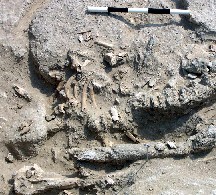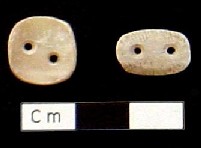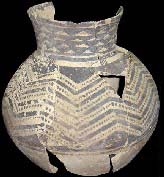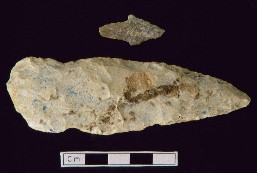|
Home
to the oldest and best preserved human-made structures
in the Gulf area as well as the UAE’s oldest human
remains, which were discovered there in 2004, the island
has already revealed to scientists a lot about the way
the UAE’s first inhabitants lived.
How it all began
Marawah island has attracted the
attention of archaeologists since the early 1990s when a
series of studies by the Abu Dhabi Islands
Archaeological Survey (ADIAS) identified a total of 13
major sites ranging in date from the Late Stone Age, to
the Bronze Age (3,150-1,200 BC), the Iron Age
(1,200-586), the Islamic period (7th-18th century) and
Late Islamic period as well as the pre-oil period.
Subsequent studies revealed an even greater number of
sites of historical significance and have paved the way
for declaring the island a part of the Marawah Marine
Protected Area.
MR-11, as
the site of the UAE’s oldest houses is known to
archaeologists, was first discovered in 1992. Located in
the south-western corner of the island, the site was
originally thought to contain a series of pre-Islamic
burial mounds.
In 2000,
further excavations were carried out at MR-11 and
another hypothesis was formed. As the building’s size
and dimensions were similar to those of a structure
previously found on the island of Sir Bani Yas, the team
in charge decided they had come across some sort of a
‘church’ or a monastic complex.
This
hypothesis was to be shattered only a few years later.
Excavations in 2003 and 2004 lead by ADIAS Senior
Resident Archaeologist, Dr Mark Beech, who has extensive
experience from major research projects in Bulgaria, the
Czech Republic, Pakistan, Jordan and Kuwait, uncovered a
truth that surpassed even the wildest of dreams. In
spring 2003, the team examined a group of stone mounds
which turned out to be three buildings. When one of the
structures was fully excavated, the scientists became
aware they had discovered a house. The house was in a
very good condition with its stone walls standing to a
height of almost a metre. At the site the team also
found a fine flint spearhead about three inches long,
and flint arrowhead along with the remnants of a stone
pestle, which the building’s inhabitants most likely
used to grind food.
What was
thought to be a ‘church’ complex turned out to be a
group of houses, built from local stone with walls
approximately half a metre thick. Radiocarbon tests
brought an even bigger scoop – the buildings were not
only extremely well preserved, but also very old, in
fact, the oldest such houses in the Arabian Gulf.
According to tests carried out at Britain's University
of Glasgow, the houses were 7,000 years old – about two
millennia older than the earliest Pharaoh in Egypt!
The houses
are dated to what is called the Arabian Neolithic Era,
corresponding to the Late Stone Age. In a statement
issued to media after the finds, Dr. Beech said: “These
structures are amazing in terms of historic importance.
They are the best and most complete structures found in
the whole (Gulf) region." Similar but less preserved
houses have been found in Shagra, Qatar and at Sabiyah,
Kuwait.
In 2004,
Dr. Beech and archaeologists from the Birmingham
Archaeology Unit and UAE archaeologist Mohammed Hassan,
set out to continue the work started the previous year.
More information about the housing complex was revealed
as one of its buildings was excavated more extensively.
The building contained at least four rooms, constructed
using the double-skin method, which was not previously
identified on sites of the same period in the region.
The double-skin method involves placing large stones as
inner and outer layers of a building and then filling
the cavities within the structure with smaller stones.

On
the site, the archaeologists also stumbled upon
fragments of a decorated pot and fragments of plaster
vessels, some of which were painted. Other finds
included a small collection of flint tools, more than
100 beads, fish, dugong and turtle bones, and bones from
either sheep or goats. Of particular interest were two
beautiful buttons made from pearl oyster shells.
But what generated the biggest amount of interest were
the remains of a human, which were the oldest trace of
human life in the country.
The UAE’s oldest inhabitant
The skeleton of the UAE’s earliest
known inhabitant was found placed on a stone platform in
a room within the excavated building. The skeleton was
buried resting on its left side with its head facing to
the north-east. It was found with its legs bent upwards
as if the body was curled up.
The person had been buried just inside the threshold of
the room, which indicates the building was not in
regular use by the time of the burial. The bones were
damaged and scattered with the feet lying several yards
away from the rest of the body. As the remains had been
disturbed, possibly due to the collapse of the
building’s roof or because someone had tripped over
them, it was not easy for scientists to determine the
sex of the diseased at first. However, forensic experts
at the Abu Dhabi Police Headquarters studied the DNA in
several well-preserved teeth discovered next to the
skeleton and found that it was a male, aged between 20
and 40 years. The scientists are still working on
determining the cause of death.
Who were the UAE’s first inhabitants?
The recent discoveries in Marawah
make the tiny island the point where UAE history begins.
From the finds at MR-11, archaeologists had determined a
few very important facts about the way the country’s
first people lived.
It seems the ancient people inhabiting the modern-day
Emirates were not all Bedouins. The inhabitants of
Marawah Island, for example, were a settled society
which used the sea as a source of food. Bone remains
found at MR-11 suggest that ancient community fished
extensively and used to catch species such as dolphins,
dugongs, turtles, shellfish, including the pearl oyster.
Scientists are now hypothesizing that the pearl trade of
the Southern Gulf area most probably began at that time.
Not only were the Marawah people excellent fishermen,
but they used to raise domestic animals as well. They
had sheep and goat and also supplemented their menu by
hunting animals such as gazelles.
It seems the Marawah people were also skilled tradesmen.
An ancient pottery vessel found at MR-11 suggests they
might have traded with southern Mesopotamia. The 7,000
year-old vessel, painted with black geometric lines and
chevrons, is typical of the region of Tell Al-Ubaid in
today’s southern Iraq, and suggests trading links
between the Gulf and Mesopotamia might be older than
originally thought.



What is radiocarbon dating?
Radiocarbon dating, the method
used to determine the age of the finds on Marawah
island, revolutionarised archaeology when it was
launched in 1949 and has ever since been hailed as one
of the most significant scientific discoveries in the 20th
century.
Radiocarbon
dating is possible because all living things absorb
carbon dioxide, which contains a form of radioactive
carbon called Carbon 14. When an organism dies, it no
longer takes carbon atoms from the atmosphere and the
amount of Carbon14 within it decreases. This process is
called radiocarbon decay. The rate of change of this
process can be measured. Carbon 14 has a half-life of
about 5700 years, which means that, after this amount of
time, each organism retains one-half the amount of
Carbon 14 it had immediately after death. The
radiocarbon dating method has been used throughout the
world to help scientists determine when an organism died
and thereby the age of the organism. Radiocarbon dating
can also be performed on organic matter produced from
living organisms such as charcoal, paint, glue, leather,
textiles and clothes, pottery, paper, etc.
The father
of radiocarbon dating is University of Chicago scientist
William Libby, who published the first radiocarbon dates
in 1949. To test his method, Libby had measured the
dates of archaeological finds, whose age had already
been established using other methods. Libby’s discovery
revolutionarised archaeology as it allowed scientists to
establish chronologies in cultures that lacked
timescales, such as calendars. Shortly after Libby’s
publication, the new method was eagerly embraced by
scientists and by the early 1950s there were already
eight radiocarbon dating laboratories in the world. In
1960, Libby was awarded the Nobel Prize in Chemistry. At
present, there are over 130 radiocarbon dating
laboratories around the world and their findings are
used in many different fields besides archaeology,
including hydrology, atmospheric science, oceanography,
paleoclimatology and biomedicine.
Futher
information on the Marawah finds, and of other work by
the Abu Dhabi islands Archaeological Survey, ADIAS, can
be found on its website: www.adias-uae.com. | 